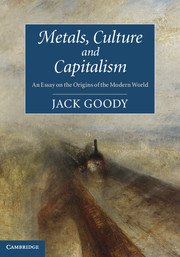Book contents
- Frontmatter
- Contents
- Maps
- Plates
- Preface
- Acknowledgements
- Chronology
- Part I Explorers
- Part II Merchants
- 7 ‘Capitalism’, exchange and the Near East
- 8 China and the Eurasian corridor
- 9 Renewal in the west
- 10 Venice and the north
- Part III Accumulators
- Appendix 1 The metallurgy of iron
- Appendix 2 Damascene steel and blades
- Glossary (with the aid of J. A. Charles)
- Bibliography
- Index
- Plate section
8 - China and the Eurasian corridor
Published online by Cambridge University Press: 05 June 2014
- Frontmatter
- Contents
- Maps
- Plates
- Preface
- Acknowledgements
- Chronology
- Part I Explorers
- Part II Merchants
- 7 ‘Capitalism’, exchange and the Near East
- 8 China and the Eurasian corridor
- 9 Renewal in the west
- 10 Venice and the north
- Part III Accumulators
- Appendix 1 The metallurgy of iron
- Appendix 2 Damascene steel and blades
- Glossary (with the aid of J. A. Charles)
- Bibliography
- Index
- Plate section
Summary
The search for metals and other products went on of course not only in the Mediterranean to the west but also to the east, to the hill country of the Zagros mountains and of the Persian plateau along the route that led to India and to China. Despite the collapse of the Roman Empire in the west, in the latter countries iron-working flourished. Like the ‘barbarians’ in the west, the inhabitants, especially the Persians, proved to be the conquerors and to some extent the successors of the Mesopotamian civilisation of the valleys.
The development of those regimes, where bronze metallurgy had begun, is instructive. The Iron Age ‘started’ in the east about 1300 bce marked by major disturbances in the region and the appearance of the Medes in the Zagros mountains on the Iranian plateau. These were people who had also acquired the techniques of metal-working from the settled urban communities but were largely dependent upon a pastoral economy and consequently could raise a mobile military force. Indeed these Indo-European-speaking horsemen became dominant in the politics of the region. The Zagros mountains were of course a place where early domestication had taken place. The whole area became one that challenged Mesopotamian hegemony, and would both attack others and defend itself. It was there that various groups emerged, not only the Medes and the Scythians but also the Achaemenians, that is, the dynasty founded by Cyrus in about 550 bce and that in 331 bce was conquered by Alexander of Macedon, another great Iron Age general. He in turn founded his own dynasty, the Seleucids, which was followed by the Parthians and then by the Sasanians (c. 224–651 ce), both of whom controlled the western Silk Road, just as Alexander had fought his way to Bactria in Central Eurasia, which communicated with China, and from there entered the north of India, attempting to return via Baluchistan.
- Type
- Chapter
- Information
- Metals, Culture and CapitalismAn Essay on the Origins of the Modern World, pp. 153 - 186Publisher: Cambridge University PressPrint publication year: 2012



